Search results for: 'Rom'
-
 Museum quality grindstone from the late Neolithic
Museum quality grindstone from the late NeolithicHochinteressantes und äußerst seltenes Werkzeug aus der jüngeren Steinzeit oder angehenden Bronzezeit. Eindrucksvolle Nutzungsspuren vom Schleifen von Klingen aus Stein oder Bronze.
Price: on request Thin butted axe head from the Funnel Beaker culture
Thin butted axe head from the Funnel Beaker cultureHellgrauer bis dunkelgrauer Flint. Massiver Beilkopf, der durch Größe und Gewicht beeindruckt. Dolmenzeit bis Ganggrabzeit, 3900 bis 3000 v. Chr.
Price: on request Neolithic axe head from the Corded Ware culture
Neolithic axe head from the Corded Ware cultureDicknackiger Beilkopf aus Feuerstein. Variante des Kregme-Typs. Einzelgrabkultur oder evt. Anfang der Dolchzeit, 2800 v. Chr. bis 1800 v. Chr.
Price: on request Michelsberger culture artefacts from museum stock - found in Camp-a-Cayaux, Belgium
Michelsberger culture artefacts from museum stock - found in Camp-a-Cayaux, BelgiumFunde vom Camp-a-Cayaux, bei neolithischer Flintmine in Spiennes, Belgien. Abschläge und Werkzeuge. 4500 v. Chr. bis 3500 v. Chr.
Price: on request Missale Romanum - rare 1610 missal
Missale Romanum - rare 1610 missalSchweinsledereinband auf Holzdeckeln. Aus der Sammlung Prof. H. Brosch, Autor historischer Fachpublikationen und wissenschaftlicher Museumsbeirat. Träger des Bundesverdienstkreuzes.
Price: on request Fragment of a stamped Roman tile
Fragment of a stamped Roman tileThe stamp AYK is not discussed in the literature at hand and thus may be rare.
Price: on request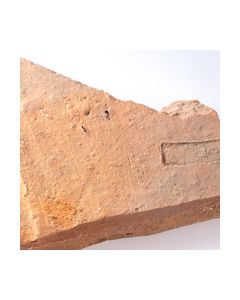 Fragment of a stamped Roman tile
Fragment of a stamped Roman tileProbably manufactured in Treves area, Germany. Roman Empire, 3rd - 4th century A.D.
Price: on request Roman oil lamp - found in England
Roman oil lamp - found in EnglandFundregion: England. Faszinierendes Belegstück für das Ausmaß des antiken Handels. Museale Erhaltung.
Price: on request Roman sandal sole type fibula
Roman sandal sole type fibulaDie Form wird in der Literatur als Schuh- oder Sandalensohle bezeichnet. Der sehr dekorative Fibeltyp war extrem beliebt und im zweiten Jahrhundert weit verbreitet. Er stammt aus den nördlichen römischen Provinzen.
Price: on request Double spiral pendant from Bronze Age Central Europe
Double spiral pendant from Bronze Age Central EuropeTypical decorative element of a wealthy woman's dress in the European Middle Bronze Age. Several of these spiral pendants were worn around the waist. Similar to belt mounts or charms. 1500 to 1200 BC.
Price: on request Whistle from plastic bronze
Whistle from plastic bronzeNice small whistle made of a high lead content bronze. Probably produced in the Modern Age.
Price: on request Celtic gold stater from the age of Caesar's Gallic Wars
Celtic gold stater from the age of Caesar's Gallic WarsExtremely fine Ambiani gold stater, 60-25 BC. AV: Plain bulge (remnants of the head of Apollo); RV: Abstract horse right, below and above dots and sickles.
Price: on request Double spiral pendant from Bronze Age Central Europe
Double spiral pendant from Bronze Age Central EuropeTypical decorative element of a wealthy woman's dress in the European Middle Bronze Age. Several of these spiral pendants were worn around the waist. Similar to belt mounts or charms. 1500 to 1200 BC.
Price: on request Decorated Roman Terra Sigillata bowl
Decorated Roman Terra Sigillata bowlVery fine condition, 2nd century AD. Probably found in Trier area.
Price: on request Decorated Roman Terra Sigillata bowl
Decorated Roman Terra Sigillata bowlVery fine condition, 2nd century AD. Probably found in Trier area.
Price: on request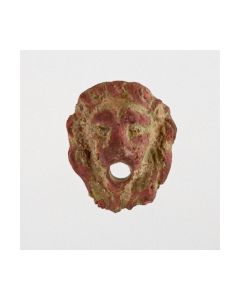 Roman bronze mount shaped as a lion's head
Roman bronze mount shaped as a lion's headFound in Dunham on Trent, Nottinghamshire, Great Britain on 8th of November 2013
€150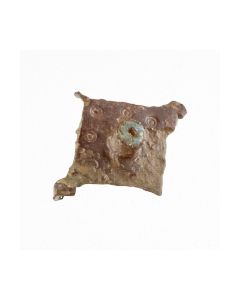 Roman fibula from the Richard Hattatt collection
Roman fibula from the Richard Hattatt collectionLozenge-shaped ancient roman fibula. The piece is published in the standard work "Iron Age and Roman Brooches". Found in Britain.
Price: on request Published Roman fibula with celtic design
Published Roman fibula with celtic designAncient fibula from the Roman province of Britain. The design can be attributed to the celtic tribe of the Trinovantes or Iceni. From the famous Hattatt collection. Published twice.
Price: on request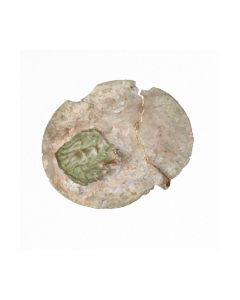 Ancient fibula from the Hattatt collection
Ancient fibula from the Hattatt collectionAncient fibula of the rare adlocutio type. Repoussé work of a scene from a Roman sestertius of Hadrian in celtic style. Find from Dorset in Roman Britain. Published in Hattatts famous book series on ancient fibulae.
Price: on request Roman jar or beaker, probably found in Trier area.
Roman jar or beaker, probably found in Trier area.Interesting piece from a German collection.
Price: on request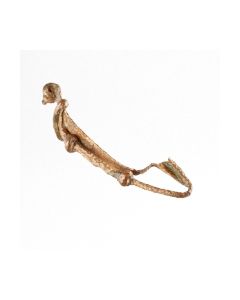 Celtic fibula from the famous Hattatt collection
Celtic fibula from the famous Hattatt collectionFibula from the La Tène II period. Found in Celtic Carnuntum. The piece is published in the standard work "Iron Age and Roman Brooches".
Price: on request Roman jar with flat handle
Roman jar with flat handlePerfectly preserved piece from a very old German collection.
Price: on request Roman beaker
Roman beakerDelicate piece from a very old German collection.
Price: on request Roman jar with flat handle
Roman jar with flat handlePerfectly preserved piece from a very old German collection.
Price: on request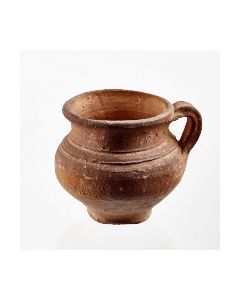 Massive small Roman pot with handle
Massive small Roman pot with handleImpressive, perfectly preserved piece from a very old German collection.
Price: on request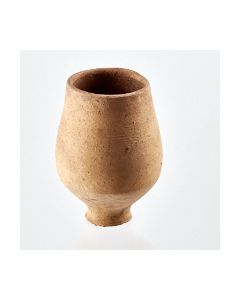 Roman beaker
Roman beakerLarge, nicely preserved piece from a very old German collection.
Price: on request Roman jar, probably found in Trier area.
Roman jar, probably found in Trier area.Perfectly preserved piece from a German collection.
Price: on request Roman oil lamp showing Victoria in biga
Roman oil lamp showing Victoria in bigaA lamp with an identical motive is on exhibition in the NATIONAL WARSAW MUSEUM. Probably found in Trier in 1913
Price: on request Roman oil lamp found 1913 in Trier
Roman oil lamp found 1913 in TrierPerfectly preserved piece with a particularly old known history.
Price: on request Juglet from the Urnfield period
Juglet from the Urnfield periodSmall juglet dating to the transition period between Bronze Age and Iron Age in Central Europe. 1200 to 800 BC. Found in an urnfield in Lower Austria.
Price: on request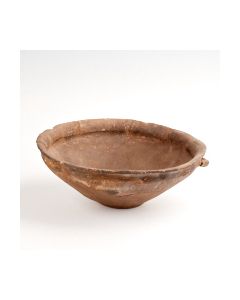 Big bowl from the Urnfield period
Big bowl from the Urnfield periodCeramic vessel dating to the transition period between Bronze Age and Iron Age in Central Europe. 1200 to 800 BC. Found in an urnfield in Lower Austria.
Price: on request Roman fibula
Roman fibulaAncient roman fibula of the kraeftig profilierte fibula type. The piece is a beautiful example of this common type of fibulae during roman imperial times.
Price: on request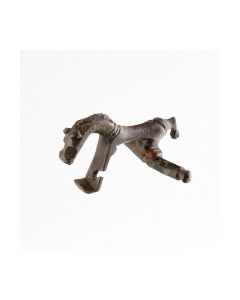 Roman horse fibula
Roman horse fibulaSkillfull bronze fibula in horse shape. The type was used in Central Europe during the later Principate.
Price: on request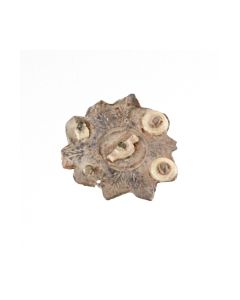 Elaborate Roman plate brooch
Elaborate Roman plate broochTen pointed star form with leaf pattern and decorative buttons. A product of Gaul or Britain dating to the 1st century.
Price: on request Roman plate brooch with colourful enamel
Roman plate brooch with colourful enamelRare fibula type from Roman Britain. The fully intact multicoloured enamel makes this piece worthy of being a museum exhibit. 2nd cent. AD.
Price: on request Bird shaped Roman brooch
Bird shaped Roman broochProduct of Northern Europe dating to the second century AD. Brooch worked as a flat relief, once with multi-coloured inlays.
Price: on request

